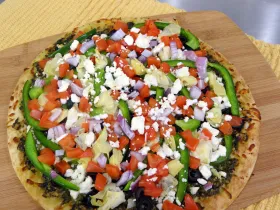Pesto Pizza
Preparation time: 10 minutes
Cook time: 10 minutes
1 (12-inch) pre-baked thin-crust pizza crust
4 oz. pesto
1 ripe tomato, chopped
½ c. green bell pepper, chopped
2 oz. chopped black olives, drained (optional)
½ small red onion, chopped
1 (4-oz.) can artichoke hearts, drained and sliced
1 c. crumbled feta cheese (could use vegan cheese substitute)
Preheat oven to 450 F. Spread pesto on pizza crust. Top with tomatoes, bell peppers, olives (if desired), red onions, artichoke hearts and feta cheese. Bake for eight to 10 minutes, or until cheese is melted and browned.
*Optional: Add firm tofu if desired to boost protein content.
Makes six servings. Each serving has 300 calories, 15 g fat, 10 g protein, 6 g carbohydrate, 2 g fiber and 800 mg sodium.
Menu idea: Pesto Pizza, lettuce salad, cottage cheese with fruit, milk or substitute
Chickpea Sandwiches
Chickpea Sandwiches
Preparation time: 20 minutes
1 (15-oz.) can garbanzo beans, drained and rinsed
1 stalk celery, chopped
¼ medium onion, chopped
1 Tbsp. mayonnaise
1 Tbsp. lemon juice
1 tsp. dried dill weed
Ground black pepper (to taste)
Salt (if desired, to taste)
Drain and rinse chickpeas. Pour chickpeas into a medium-size mixing bowl and mash with a fork. Mix in celery, onion, mayonnaise (to taste), lemon juice, dill weed and pepper. Serve on whole-grain bread or buns.
*Optional: Add tuna, sliced hard-cooked eggs or silken tofu.
Makes three servings. Each serving (with two slices whole-wheat bread) has 280 calories, 5 g fat, 13 g protein, 46 g carbohydrate, 9 g fiber and 480 mg sodium.
Menu idea: Chickpea Sandwich, lettuce salad, fruit smoothie (yogurt and frozen berries)
Savory Rice and Beans
Savory Rice and Beans
Preparation time: five minutes • Cook time: 25 minutes
1 Tbsp. olive oil
1 medium onion, chopped
2 cloves garlic, minced
1 (14.5-oz.) can low-fat vegetable broth
¾ c. uncooked white rice
½ tsp. cayenne pepper
1 medium tomato, diced
2 (15-oz.) cans black beans, drained and rinsed
In a stockpot over medium-high heat, heat the oil. Add the onion and garlic and sauté for four minutes. Add the rice and sauté for two minutes.
Add the vegetable broth, bring to a boil, cover and lower the heat and cook for 20 minutes. Add the spice, tomato and black beans. Cook over medium heat two minutes or until heated through.
The recipe makes 10 servings. Freeze the leftovers in meal-size amounts or refrigerate and eat within four days. Each serving has 180 calories, 2.5 g fat, 8 g protein, 31 g carbohydrate, 6 g fiber and 350 mg sodium.
Menu idea: Savory Rice and Beans, steamed asparagus, fresh fruit, milk or substitute
Colorful Veggie Kabobs
Preparation time: 20 minutes
2 medium zucchini, cut in 1-inch pieces
1 large onion, cut into ½-inch thick pieces
1 green bell pepper, cut into 1-inch strips
1 yellow bell pepper, cut into 1-inch strips
1 small pkg. cherry tomatoes
½ lb. mushrooms, quartered
1/3 c. oil-based salad dressing, such as Italian
If using bamboo skewers, soak them in water for two hours prior to using to reduce charring. Thread vegetables alternately on skewers. Brush generously with salad dressing. Grill for three minutes; turn vegetables over, brushing with extra salad dressing. Grill for another three to four minutes until done.
Not able to go outside? Try broiling the kabobs. Place an oiled pan with kabobs about 6 inches from the top of the preheated oven. Turn over once and cook until golden brown (about six minutes).
Makes six servings. Each serving has 150 calories, 8 g fat, 5 g protein, 17 g carbohydrate, 4 g fiber and 360 mg sodium.
Menu idea: Colorful Veggie Kabobs, quinoa, grilled veggie burger, grilled pineapple, milk or substitute
The NDSU Extension Service does not endorse commercial products or companies even though reference may be made to tradenames, trademarks or service names. NDSU encourages you to use and share this content, but please do so under the conditions of our Creative Commons license. You may copy, distribute, transmit and adapt this work as long as you give full attribution, don’t use the work for commercial purposes and share your resulting work similarly. For more information, visit www.ag.ndsu.edu/agcomm/creative-commons.
For more information on this and other topics, see www.ag.ndsu.edu/food
County commissions, North Dakota State University and U.S. Department of Agriculture cooperating. NDSU does not discriminate in its programs and activities on the basis of age, color, gender expression/identity, genetic information, marital status, national origin, participation in lawful off-campus activity, physical or mental disability, pregnancy, public assistance status, race, religion, sex, sexual orientation, spousal relationship to current employee, or veteran status, as applicable. Direct inquiries to Vice Provost for Title IX/ADA Coordinator, Old Main 201, NDSU Main Campus, 701-231-7708, ndsu.eoaa@ndsu.edu. This publication will be made available in alternative formats for people with disabilities upon request, 701-231-7881. 2018; web-4-23




